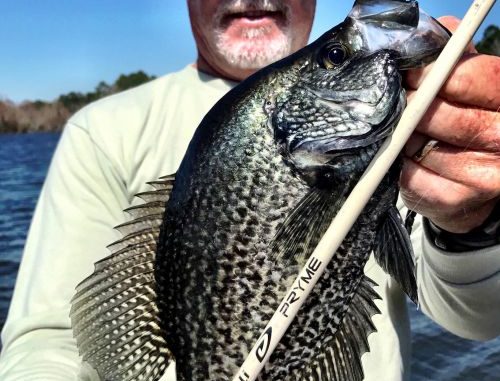
But don’t fish shallow for spawners — target wood cover in 12 to 25 feet of water, guide says
Toledo Bend has been tagged as the nation’s No. 1 bass fishery two years running, but Dennis Tietje said there’s another reason to head to the sprawling border lake right now.
“I think it’s a better crappie lake than a bass lake right now,” said Tietje, who guides for ADCO Rod and Reel Repair and Guide Service when he’s not running around the country as a touring FLW bass pro.
He and his customers have been crushing the tasty panfish, finding huge schools ganged up around wood cover.
But don’t go looking for shallow spawning fish if you want to get in on the action.
“What you’re seeing is a lot of the crappie didn’t spawn shallow,” Tietje said. “They ended up suspended in the brush piles and trees earlier than normal.”
Success has come around stumps in 12 feet of water all the way out to brush piles in 25 feet of water.
“The fish won’t be on the bottom — they’ll be suspended,” Tietje said.
He said he’s had success and heard great reports the length of the lake, and everything seems to be happening deep already.
“There’s no (shallow) grass for them to spawn in,” Tietje said. “They don’t want to be there.”
He said the keys lately have been plastics on 1/16-ounce jigs tipped with Strike King Shadalicious swim baits or tiny Flukes.
“Sometimes they want that tail action (of the Shadalicous bodies), and sometimes they want it to look more like a minnow,” the angler said.
Natural minnow colors are his preference, and 6-pound line is best.
“Believe it or not, with 8-pound-test line, you won’t get as many bites,” Tietje said. “I think that has to do with the way the lure falls.”
His technique is to flip his jig out 12 to 14 feet from the boat and let it pendulum back.
“Half of the bites will come on the initial fall, and half on the rise,” Tietje explained. “If they’re real active and that lure falls through a school, they’ll eat it.”
If the jig reaches the end of the pendulum swing, Tietje starts lifting his rod tip very slowly. But he doesn’t reel in line.
“I’ll slowly raise my arms as high as I can,” he said. “I have two theories on why that triggers bites. First, I think crappie feed in certain depths, so when you pull that lure up you eventually hit that depth. Second, when you lift the lure, it looks like it’s swimming away, and that school will rush up there. If that happens, you will have two or three fish that will bite.”
When his arms are as high as he can lift them without a bite, Tietje drops the rod tip to allow the bait to free-fall.
“That looks like a wounded baitfish,” he said.
All it takes to box a lot of crappie when they’re schooled up is to get one or two fish to bite.
“As long as you keep them activated, you can sit there and catch them,” Tietje said. “I’ve caught 200 before off of one hole.”
The key is to keep baits in the water — if a school settles down, you’ll have to trick the fish into becoming active again.
“If you’re catching fish and you stop to take a picture of a big one or something, the fish will not be as active,” Tietje said.
Action on plastics will continue until water temps top 75 degrees, at which time live minnows will become the most effective baits.
While Tietje is enjoying the hot bite, he said the lack of shallow vegetation is concerning.
“We’re catching fish holding eggs,” he said. “Will those fish spawn out on those limbs (of the deep brush and trees around which they are suspended)? I don’t know.
“That raises a question for years to come.”


